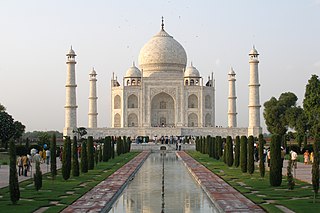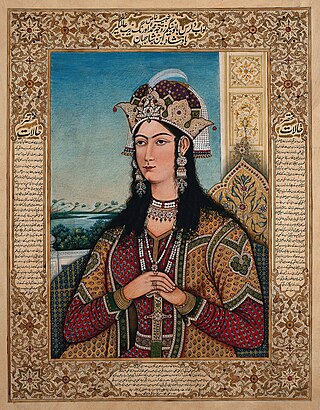
Mirza Shahab-ud-Din Muhammad Khurram, also known as Shah Jahan I, was Emperor of Hindustan from 1628 until his deposition in 1658. As the fifth Mughal emperor, his reign marked the zenith of Mughal architectural and cultural achievements.

Ustad Isa Shirazi was a Persian architect from the city of Shiraz in Safavid Persia often described as the assistant architect of the Taj Mahal in Agra, India.

Mumtaz Mahal was the empress consort of Mughal Empire from 1628 to 1631 as the chief consort of the fifth Mughal emperor, Shah Jahan. The Taj Mahal in Agra, often cited as one of the Wonders of the World, was commissioned by her husband to act as her tomb.

Jahanara Begum was a princess of the Mughal Empire. She was the second and the eldest surviving child of Mughal Emperor Shah Jahan and Mumtaz Mahal.

Dara Shikoh, also transliterated as Dara Shukoh, was the eldest son and heir-apparent of the Mughal emperor Shah Jahan. Dara was designated with the title Padshahzada-i-Buzurg Martaba and was favoured as a successor by his father and his elder sister, Princess Jahanara Begum. He had been given the title of 'Shah-e-Buland Iqbal' by Shah Jahan. In the war of succession which ensued after Shah Jahan's illness in 1657, Dara was defeated by his younger brother Prince Muhiuddin. He was executed in 1659 on Aurangzeb's orders in a bitter struggle for the imperial throne.

The Agra Fort is a historical fort in the city of Agra, also known as Agra's Red Fort. Mughal emperor Humayun was crowned at this fort in 1530. It was later renovated by the Mughal emperor Akbar from 1565 and the present-day structure was completed in 1573. It served as the main residence of the rulers of the Mughal dynasty until 1638, when the capital was shifted from Agra to Delhi. It was also known as the "Lal-Qila" or "Qila-i-Akbari". Before being captured by the British, the last Indian rulers to have occupied it were the Marathas. In 1983, the Agra fort was inscribed as a UNESCO World Heritage Site because of its importance during Mughal rule. It is about 2.5 kilometers (1.6 mi) northwest of its more famous sister monument, the Taj Mahal. The fort can be more accurately described as a walled city. It was later renovated by Shah Jahan.

Līlāvatī is a treatise by Indian mathematician Bhāskara II on mathematics, written in 1150 AD. It is the first volume of his main work, the Siddhānta Shiromani, alongside the Bijaganita, the Grahaganita and the Golādhyāya.

Mughal architecture is the type of Indo-Islamic architecture developed by the Mughals in the 16th, 17th and 18th centuries throughout the ever-changing extent of their empire in the Indian subcontinent. It developed from the architectural styles of earlier Muslim dynasties in India and from Iranian and Central Asian architectural traditions, particularly Timurid architecture. It also further incorporated and syncretized influences from wider Indian architecture, especially during the reign of Akbar. Mughal buildings have a uniform pattern of structure and character, including large bulbous domes, slender minarets at the corners, massive halls, large vaulted gateways, and delicate ornamentation; examples of the style can be found in modern-day Afghanistan, Bangladesh, India and Pakistan.

Tomb of I'timād-ud-Daulah is a Mughal mausoleum in the city of Agra in the Indian state of Uttar Pradesh. Often described as a "jewel box", sometimes called the "Bachcha Taj" or the "Baby Taj", the tomb of I'timād-ud-Daulah is often regarded as a draft of the Taj Mahal.

The Bibi Ka Maqbara is a tomb located in the city of Aurangabad in the Indian state of Maharashtra. It was commissioned in 1660 by the Mughal emperor Aurangzeb's son prince Azam Shah in the memory of his loving mother Dilras Banu Begum. It bears a striking resemblance to the Taj Mahal, the mausoleum of Aurangzeb's mother, Mumtaz Mahal and that is why it is also called the Taj of the Deccan. Aurangzeb was not much interested in architecture though he had commissioned the small, but elegant, Moti Masjid at Delhi. Bibi Ka Maqbara is the second largest structure that Aurangzeb has built, the largest being the Badshahi Mosque.

Ustad Ahmad Lahori (c.1580–1649) also known as Ahmad Ma'mar Lahori was the chief Mughal architect and engineer during the reign of emperor Shah Jahan. He was responsible for the construction of several Mughal monuments, including the Taj Mahal in Agra and the Red fort in Delhi; both of which are World Heritage sites. He also designed the Jama Mosque in Delhi.

The Taj Mahal represents the finest and most sophisticated example of Indo-Islamic architecture. Its origins lie in the moving circumstances of its commission and the culture and history of an Islamic Mughal empire's rule of large parts of India. The distraught Mughal Emperor Shah Jahan commissioned the project upon the death of one of his favorite wives Mumtaz Mahal.
Shaikh Inayat-Allah Kamboh (1608–1671) was a Punjabi Muslim scholar, writer and historian during the Mughal era. He was son of Mir Abdu-lla, Mushkin Kalam, whose title shows him to also have been a fine writer. Shaikh Inayat-Allah Kamboh was the elder brother and teacher of Muhammad Saleh Kamboh, the famous historian of Shah Jahan's court and the teacher of Mughal Emperor Aurangzeb. He died in 1671 AD in Delhi, and his Maqbara is located in Guband Kambohan wala on Empress Road near Railways Headquarters, Lahore.
The Golden Age of Islam, which saw a flourishing of science, notably mathematics and astronomy, especially during the 9th and 10th centuries, had a notable Indian influence.

Dilras Banu Begum was the first wife and chief consort of Emperor Aurangzeb, the sixth Mughal emperor. She is also known by her posthumous title, Rabia-ud-Durrani. The Bibi Ka Maqbara in Aurangabad, which bears a striking resemblance to the Taj Mahal, was commissioned by her husband to act as her final resting place.
Bijaganita was treatise on algebra by the Indian mathematician Bhāskara II. It is the second volume of his main work Siddhānta Shiromani alongside Lilāvati, Grahaganita and Golādhyāya.

Abu'l-Hasan entitled by the Mughal emperor Jahangir as Asaf Khan, was the Grand Vizier of the fifth Mughal emperor Shah Jahan. He previously served as the vakil of Jahangir. Asaf Khan is perhaps best known for being the father of Arjumand Banu Begum, the chief consort of Shah Jahan and the older brother of Empress Nur Jahan, and the maternal grandfather of mughal emperor Aurangzeb.

Persian Inscriptions on Indian Monuments is a book written in Persian by Dr Ali Asghar Hekmat E Shirazi and published in 1956 and 1958 and 2013. New edition contains the Persian texts of more than 200 epigraphical inscriptions found on historical monuments in India, many of which are currently listed as national heritage sites or registered as UNESCO world heritage, published in Persian; an English edition is also being printed.
Khulasat-ut-Tawarikh is a Persian language chronicle written by Sujan Rai Bhandari in the Mughal Empire of present-day India. It deals with the history of Hindustan, and it also contains details about the contemporary Mughal Empire. Sujan Rai completed the book in 1695 CE, during the reign of Aurangzeb. An insertion about Aurangzeb's death was later added to the original copy by a transcriber.

Shalimar Bagh also known as Shalimar Garden is a Mughal garden located on the banks of Yamuna river in Delhi, India. It was named as Aizzabad Bagh when the garden was laid by Izz-un-Nissa wife of Mughal emperor Shah Jahan in 1653 as a tribute and replica of Shalimar Bagh, Kashmir, laid by erstwhile Mughal emperor Jahangir in 1619, the Shalimar Bagh of Delhi is now abandoned but still houses shade trees, majestic parterre and structure such as the Sheesh Mahal and the garden pavilion.
















